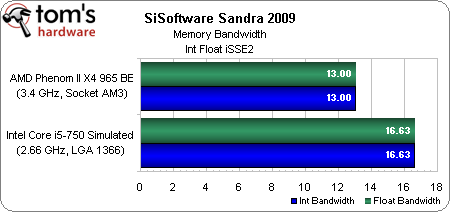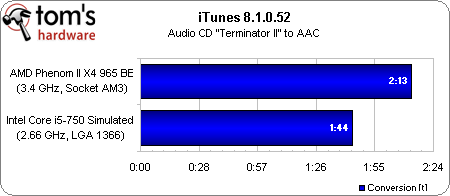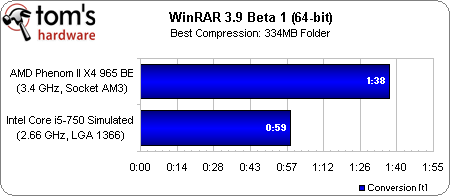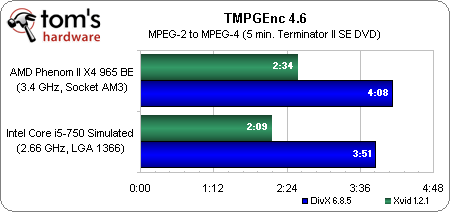AMD Phenom II X4 965 Black Edition Review
A Brief Interlude: Phenom II Versus Core i5
Before we dig into the complete Phenom II X4 965 BE review, let's look at our approximated Core i5 comparison:
We’re used to seeing big bandwidth numbers from Core i7’s integrated memory controller and triple-channel DDR3 configurations. Pull one 64-bit channel out of contention and you’re still going to see significant throughput. In both test cases here, we’re looking at memory bandwidth using 4 GB (2 x 2 GB) DDR3-1333 at 7-7-7.
This represents a worst-case scenario for Core i5, since iTunes is not threaded. Normally, the chip would surge to 3.2 GHz in a situation like this one, with a single core active. Instead, it earns its win at 2.8 GHz—the best our Core i7-920 could muster.
Heavily optimized for threading, WinRAR is perhaps more demonstrative of how a Core i5 might perform in a situation with all four cores simultaneously taxed. The gain is, not surprisingly, more significant.
In both DivX and Xvid encoding, performance between the Core i5-750 and Phenom II X4 965 is close. DivX is able to take advantage of multiple cores, so its result isn’t expected to change much when Core i5 actually starts shipping. Xvid only hits 25% utilization on a quad-core platform, though, so there’s a fair chance that extra Turbo-induced frequency will give Intel’s offering a larger lead.
We only ran a handful of benchmarks here. These numbers are simulated, after all. Also, this is an AMD Phenom II review, and what matters most is how the Phenom II X4 965 fares against its competition today.
Even still, we think it’s important to be cognizant of what’s coming, so if you want to draw your own comparisons between today’s AMD launch and Intel’s planned roadmap, bear in mind that Core i5 loses one memory channel and Hyper-Threading, but gains significant one- and two-core performance thanks to a beefed-up Turbo feature. Depending on the application, that should let you derive your own expectations of Core i7-920 and Core i5-750, both with 2.66 GHz stock clocks.
Get Tom's Hardware's best news and in-depth reviews, straight to your inbox.
Current page: A Brief Interlude: Phenom II Versus Core i5
Prev Page Introduction Next Page Phenom II X4 965 Black Edition: Vitals And Overclocking-
XD_dued Hmmm...i hope the rest of the OC better. I also hope that AMD won't have to price cut too much to compete with i5. Either way, AMD really needs something new and fast....Hopefully they'll do well with the dx11 cards.Reply -
AMDnoob ugh... i want to love AMD but I'm not sure this cuts it. I mean, if you get an AMD Phenom II 955 and the 965, they're completely identical except for multiplier. And you can get both processors to 3.8Ghz most of the time. So really whats new???? The 965 has just got a faster stock frequency. But anybody who buys a 955 or 965 is prolly an enthusiast that will end up OCing them to ~3.8Ghz. So just go for the cheaper 955. The 965 sounds like AMD is trying to make something "new", but it's just another Phenom II 45nm chip w/ the same 6mb cache, etc. They need to release a new line for these up coming Intel chips.Reply -
hunter315 Excellent timing, i was just wondering when i was going to see a performance review for the new 965. Though i would like to see a benchmark comparing the overclocking potential of the 955 to the 965, im curious if its just a higher binned processor or the same one just clocked higher.Reply -
megamanx00 I better pick up the 955 BE before they are all gone. Doesn't seem like the 965 has any advantage other than the stock clock, and of course I don't plan on leaving it at stock :D.Reply -
chaohsiangchen Good article! Judging from what AMD did with 65nm Phenom, they would perhaps release 125W version in early 2010. However, that's pure projection. I will probably get this one and wait for AMD 32nm. Somebody got to support the underdog. Unfortunately, this is the same situation AMD faced during mid 2006 all over again. Intel 32nm is going to be awesome, and it seems that AMD is going to be left without an answer in H1 2010 until they can upgrade production for 32nm.Reply -
anonymous x but that Q9550 can overclock well, to the level of the phenom II 965 here and beyond, and clock for clock it is faster than phenom II.Reply
Can't wait for a AM3 vs LGA 1156 battle soon! -
steel_icon Will this run on an old AsuS Crosshair NV590A-SLI motherboard? I surely do hope so...Reply




